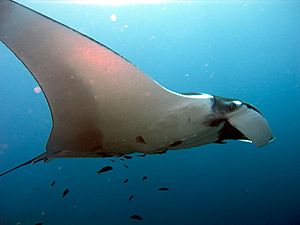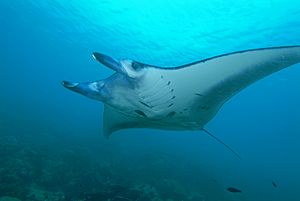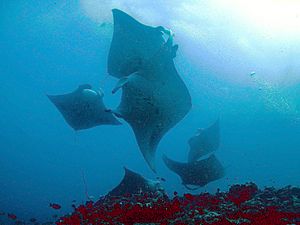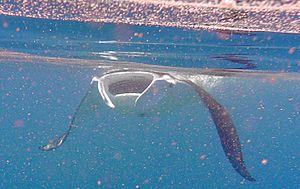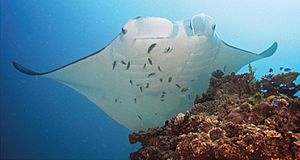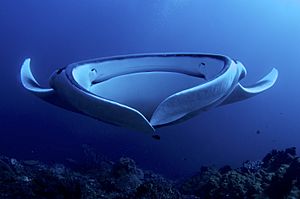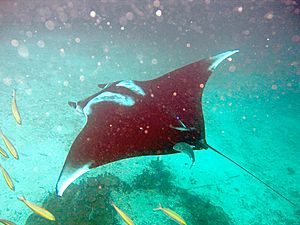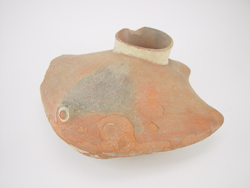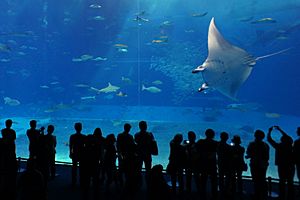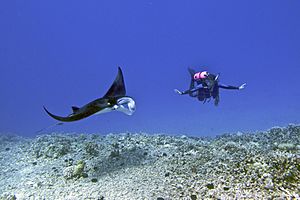Manta ray facts for kids
Quick facts for kids Manta rayTemporal range: Lower Miocene to Recent
|
|
|---|---|
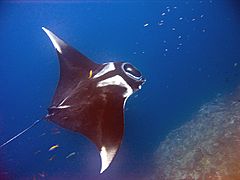 |
|
| Manta ray at Hin Daeng, Thailand | |
| Scientific classification | |
| Kingdom: | |
| Phylum: | |
| Class: | |
| Subclass: | |
| Order: | |
| Family: | |
| Genus: |
Manta
Bancroft, 1829
|
| Species: |
M. birostris
|
| Binomial name | |
| Manta birostris (Walbaum, 1792)
|
|
The manta ray (Manta birostris) is the biggest type of ray in the world. Imagine a flat fish that can grow wider than a car! The largest known manta ray was over 7.6 meters (25 feet) across. It weighed about 1300 kilograms (2,866 pounds), which is like two small cars.
Manta rays live in warm, tropical waters all around the world. You can often find them near coral reefs. They have a very large brain compared to their body size. This brain stays warm even when they dive deep into cold water, sometimes as far down as 500 meters (1,640 feet).
Scientists think there might be two different kinds of manta rays. One is the giant manta (Manta birostris), which travels long distances. The other is the reef manta (Manta alfredi), which stays closer to home. Manta rays are usually at the top of their food chain. However, some sharks, like the tiger shark, might hunt them.
Contents
Manta Ray Biology
What Manta Rays Look Like
Manta rays have wide heads and large, triangular fins on their sides, called pectoral fins. They also have two horn-shaped fins near their mouths, called cephalic fins. Their bodies are flat, and their eyes are on the sides of their heads. They have gill slits on their underside, which they use to breathe.
Their tails are shorter than their bodies and do not have bones. They also have a small fin on their back, near the tail. The biggest manta rays can weigh up to 1350 kilograms (2,976 pounds). Their width is usually about twice their body length. Giant mantas can be over 7 meters (23 feet) wide, while reef mantas are about 5.5 meters (18 feet) wide.
From above, mantas are usually black or dark with lighter marks on their "shoulders." Their undersides are often white or pale. They have unique dark spots that help identify each individual ray. Some manta rays are completely black. Their skin is covered in a slimy layer called mucus, which protects them from germs.
The two types of manta rays have slightly different looks. Giant mantas have sharper shoulder markings and larger dark spots on their bellies. Their mouths are dark. Reef mantas have rounder shoulder marks and their spots are closer to their tails. Their mouths are white.
Manta rays swim by moving their large pectoral fins like wings. This pushes water behind them. Unlike most rays, their mouths face forward, not downwards. They must keep swimming all the time. This helps oxygen-rich water flow over their gills so they can breathe. Their horn-shaped fins usually stay rolled up. But when they are eating, they flatten out to help guide food into their mouths.
Manta Ray Life Cycle
Manta rays mate at different times of the year, depending on where they live. The female ray carries her eggs inside her body. The baby rays grow inside egg cases, using the yolk for food. Once they hatch from the egg cases, they stay inside the mother. They get more food from a milky liquid the mother produces.
Baby manta rays do not have an umbilical cord like mammals. They get oxygen by pumping water through their mouths. Usually, only one or sometimes two babies are born at a time. The mother carries the babies for about 12 to 13 months. When they are ready, the baby manta rays look like tiny adults. They are born without any help from their parents after birth.
Manta rays can live for a long time, sometimes as long as 50 years!
How Manta Rays Behave
Manta rays swim differently depending on where they are. In deep water, they swim in a straight line at a steady speed. Closer to shore, they might swim slowly or just float around. They can travel alone or in groups of up to 50 rays. Sometimes, they swim with other fish, seabirds, or even marine mammals.
Mantas sometimes jump out of the water, called "breaching." They might leap partly or fully out of the water. If they are in a group, one ray might jump, then another. They can land headfirst, tail first, or even do somersaults. No one knows exactly why they jump. It could be for mating, giving birth, talking to each other, or to shake off parasites like remoras (suckerfish).
Manta rays are "filter feeders." This means they eat tiny organisms floating in the water, called zooplankton. This includes small shrimp, krill, and crab larvae. A manta ray can eat about 13% of its body weight every week! When they eat, they swim slowly around their prey, gathering it into a tight "ball." Then, they swim through the ball with their mouths wide open.
If there's a lot of food, a manta might even do a somersault through it. They flatten their horn-shaped fins to guide food into their mouths. Small food particles are caught by special tissues inside their gills. Many manta rays, sometimes up to 50, can gather at one spot with lots of plankton. Large sharks and killer whales sometimes hunt manta rays. They can also get bitten by cookiecutter sharks or have small parasites called copepods on their skin.
Manta rays visit "cleaning stations" on coral reefs. These are places where smaller fish remove parasites from the manta's skin. The ray stays still near the coral for a few minutes while the cleaner fish do their job. This often happens when the tide is high. Different fish clean different parts of the manta. Some clean around the mouth and gills, while others clean the rest of the body. Manta rays often return to the same cleaning stations or feeding areas. This suggests they remember their favorite spots.
Where Manta Rays Live
Manta rays live in warm and mild waters in all the world's main oceans. They can even go into cooler seas sometimes. They like water temperatures above 20°C (68°F). Reef mantas mostly stay in tropical areas. Both types of manta rays live in the open ocean, not usually near the bottom.
Giant mantas (M. birostris) mostly live in the open ocean. They travel with ocean currents and move to areas where rich waters bring more food. Scientists have put radio trackers on some mantas. These rays have traveled as far as 1000 kilometers (620 miles) from where they were tagged. They have also dived to depths of at least 1000 meters (3,280 feet).
Reef mantas (M. alfredi) tend to stay closer to the coast. They do move seasonally, but their trips are shorter than those of giant mantas. Manta rays are common near coasts from spring to fall. In winter, they travel further offshore. During the day, they stay close to the surface and in shallow water. At night, they swim deeper.
Protecting Manta Rays
Dangers to Manta Rays
The biggest danger to manta rays is too much fishing. Both large fishing companies and smaller local fishermen have caught mantas for their meat and other parts. They are usually caught with nets, trawls, or harpoons. In the past, mantas were caught for their liver oil and skin, which was used like sandpaper.
Their meat can be eaten, but it's not as popular as other fish. Recently, there has been a big demand for their gill rakers. These are bony structures that protect their gills. They are used in some traditional Asian medicines. Because of this demand, many manta rays are caught and killed just for these gill rakers. This has caused manta ray populations to drop a lot in places like the Philippines, Indonesia, and India.
Manta rays face other dangers from humans too. Since they must swim constantly to breathe, they can get tangled in fishing lines or nets. If they get caught, they can't swim backward. They often try to somersault to get free, which just tangles them more. This can cause serious injuries or even suffocation.
Mantas can also get hit by boats, especially in areas where many of them gather. Other things that might affect manta numbers include climate change, pollution from oil spills, and eating tiny pieces of plastic.
Manta Ray Status
In 2011, manta rays became protected in international waters. This was because they were added to the Convention on Migratory Species of Wild Animals. This means countries agreed to protect them.
Also in 2011, the reef manta (M. alfredi) was listed as 'Vulnerable'. This means their populations are small, with fewer than 1000 individuals in some places. The Manta Trust is a charity in the UK that works to research and protect manta rays.
Many countries are also taking action. New Zealand has protected manta rays since 1953. In 1995, the Maldives banned the export of all ray parts. This stopped manta fishing there. In 2009, they created two marine protected areas for mantas. The Philippines banned manta fishing in 1998, then brought the ban back in 2002 after populations dropped. Mexico banned catching mantas in 2007.
In 2009, Hawaii was the first US state to ban killing or catching manta rays. In 2010, Ecuador made a law against all fishing for manta rays.
Manta Rays and Humans
Long ago, the Moche people in Peru worshipped the sea and its animals. Their art often showed manta rays. For a long time, sailors feared mantas because of their huge size. They thought mantas ate fish and could even sink boats.
But this changed around 1978. Divers in the Gulf of California found that mantas were calm and friendly. They could even swim with them! Famous author Peter Benchley, who wrote Jaws, was one of the divers who photographed himself with mantas.
Manta Rays in Aquariums
Because manta rays are so big, it's rare to see them in aquariums. Only a few aquariums in the world have them. One famous manta ray named "Nandi" was accidentally caught in shark nets in South Africa in 2007. She was moved to the Georgia Aquarium in the US in 2008. She lives in their huge "Ocean Voyager" tank, which holds over 23 million liters (6.3 million US gallons) of water. Two more manta rays joined her there later.
The Atlantis resort in the Bahamas also had a manta ray named "Zeus." He was studied for three years before being released in 2008. The Okinawa Churaumi Aquarium in Japan also has manta rays in one of the world's largest aquarium tanks. This aquarium was the first to have a manta ray born in captivity in 2007. Although that baby didn't survive, three more manta rays were born there in 2008, 2009, and 2010.
Manta Ray Tourism
Places where manta rays gather attract many tourists. Seeing mantas helps local communities earn money. Popular tourist spots are in the Bahamas, Cayman Islands, Fiji, Thailand, Indonesia, Hawaii, Australia, and the Maldives.
Mantas are popular because they are so big and because they get used to humans easily. Divers can watch mantas visiting cleaning stations. Night dives are also popular. Lights attract plankton, and divers can watch mantas feeding on them.
Images for kids


